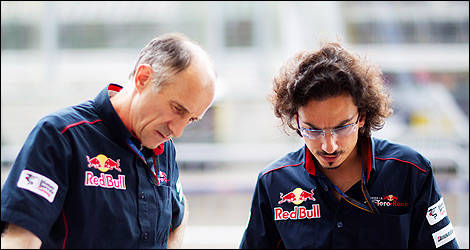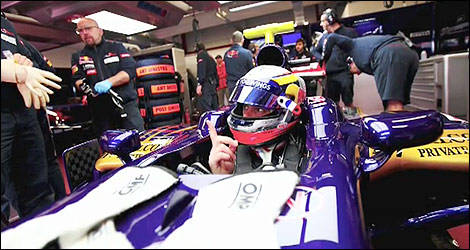Laurent Mekies, Chief Engineer at Scuderia Toro Rosso, explained us in Montreal how the Italian team manages its stock of engines and gearboxes during a full season of Grand Prix racing.
“For a full season of 20 races, we have per car a stock of eight sealed engines along with transmissions that must complete five consecutive Grands Prix,” Mekies told us.
“We basically do what we want to do with the motors. We install the engine we want, when we want it. We can even install a first engine in the car and have it run as many races as we wish. The technological development of the engine is frozen, so all engines are almost identical. We do not chose one engine for a race in particular. However, it is different with the transmissions. One unit must cover five consecutive races before it gets changed,” Mekies added.
“From our lap-time simulation software, we estimate the difference in lap times if the engine would have, for example, an additional 10 horsepower. So we determine on which circuits we need the extra horsepower from a fresh engine. Then with our engine supplier Ferrari, we plan the rotation of engines for the entire season, based on the tracks where we'll need fresh, and therefore powerful engines,” he added.
The Toro Rosso engineering team does not put into consideration if a circuit is hard on engines. In fact, the tracks where the engine makes a difference in lap times is also hard on its internal components. “The circuits where a slightly more powerful engine will make a difference are Montreal, Spa, Silverstone, Monza...” said Mekies.
Things are a bit more simple with the gearboxes. “Managing the stock of gearboxes along the season is much simpler because one has to complete five consecutive races before we change it. It's been like that for several years now, and we are now used to it,” said the French engineer.
“However, there's always a little something that can go wrong. But the current gearboxes are incredibly reliable. And that's why the F1 teams are now so big. We need a lot of people and equipment to make calculations, simulations on computers, to test the units on the dynos, to have extensive quality control, and more. There is also major investments in making better oils, lubricants and grease. Honestly, the transmissions have become extremely reliable,” Mekies ended.
“For a full season of 20 races, we have per car a stock of eight sealed engines along with transmissions that must complete five consecutive Grands Prix,” Mekies told us.
“We basically do what we want to do with the motors. We install the engine we want, when we want it. We can even install a first engine in the car and have it run as many races as we wish. The technological development of the engine is frozen, so all engines are almost identical. We do not chose one engine for a race in particular. However, it is different with the transmissions. One unit must cover five consecutive races before it gets changed,” Mekies added.
 |
| Franz Tost and Laurent Mékiès. (Photo: René Fagnan/Auto123.com) |
“From our lap-time simulation software, we estimate the difference in lap times if the engine would have, for example, an additional 10 horsepower. So we determine on which circuits we need the extra horsepower from a fresh engine. Then with our engine supplier Ferrari, we plan the rotation of engines for the entire season, based on the tracks where we'll need fresh, and therefore powerful engines,” he added.
The Toro Rosso engineering team does not put into consideration if a circuit is hard on engines. In fact, the tracks where the engine makes a difference in lap times is also hard on its internal components. “The circuits where a slightly more powerful engine will make a difference are Montreal, Spa, Silverstone, Monza...” said Mekies.
 |
| Photo: Tororosso.com |
Things are a bit more simple with the gearboxes. “Managing the stock of gearboxes along the season is much simpler because one has to complete five consecutive races before we change it. It's been like that for several years now, and we are now used to it,” said the French engineer.
“However, there's always a little something that can go wrong. But the current gearboxes are incredibly reliable. And that's why the F1 teams are now so big. We need a lot of people and equipment to make calculations, simulations on computers, to test the units on the dynos, to have extensive quality control, and more. There is also major investments in making better oils, lubricants and grease. Honestly, the transmissions have become extremely reliable,” Mekies ended.


